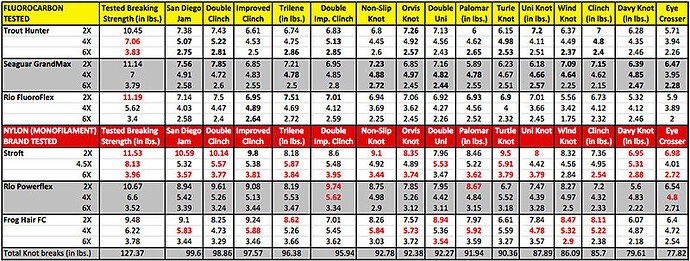Obviously this information is somewhat dated, there have been newer knot tying developments but the article holds true for the most part. Reading the replies is also very worth while. Most of this information is Pre-Tenkara, so where ever connecting to the leader is mentioned it applies to Tenkara Lines as well… Karl.
Good article, especially the point about economy of tippet material for me that I don’t often see in fly shop tippet tests that usually push the philosophy “don’t worry about using too much, tippet is cheap”.
Also interesting that despite the differences in testing methodology the findings on the weakest knots were similar to the Yellowstone Angler Tippet (& Knot) Shootout article.
I have definitely experienced the glaring problem that occurs when the tippet knot is weaker than the fly knot so I usually do an improved clinch at the tippet ring, and an Orvis knot at the fly. However sometimes (especially with 6X or smaller) I see my improved clinch knots have damaged the standing end of the tippet when tightening the knot despite moistening first, and sometimes the twists don’t nest very neatly with each other. I need ongoing brush-up practice.
Brian, thank you for the interest, comments and links. And Yes having a weaker knot at the tippet to Leader/Line Joint really hurts or helps your Tippet consumption, depending on how you look at it. If you need a weak knot at the fly, then the Clinch Knot will serve very well, and using the Improved Clinch Knot for your Fly to Tippet connection in its place will make the fly to tippet connection even weaker.
The above article does not cover the more recent developments of the Japanese Tenkara Specific Knots but, there is some Breaking Strength information posted on that under this topic, and they are in the ball park with most of the more popular general angling knots. For the most part in Tenkara fishing, we do not catch big enough fish that line breaks are a big problem. However, a lot of us probably do regularly exceed the rod makers tippet strength recommendations. So there is a need to have a Weak Link and consideration must be given to where it is placed in our line systems and knot chains.
As the article clearly shows, testing knot strength is not an exact science. The line company knot tying tutorials give the wrong impression that it is with their mechanical knot tests - that if you use a certain knot, it will break at a retain percentage of the line’s breaking strength, which is very seldom the case. It is just an estimate of the very best result you can hope for but seldom achieve. I have seen statements made that when the line does not break at either knot when doing knot against knot tests, that both knots show 100% knot strength, which is not the case at all. What such results show is that all lines have Weak Spots and that’s something anglers always have to contend with…Karl.

